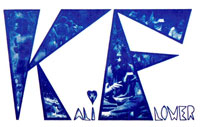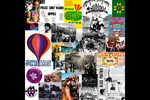Kaliflower: the
Intercommunal [Free] Newspaper
A Publication of The Free Print Shop
Out of the spinning whirlwind of Digger energy flew sparks that
caught fire in communes and communities all across the counterculture. Starting in 1967,
in California, Oregon, Arizona, Wisconsin and elsewhere, groups sprang to action and took
the Digger name in the way the Diggers had taken it from their English forebears. Others
began Digger activities under different names — the Provos in Berkeley used the name
of the Dutch group whose White Bike Plan had captured the imagination of anarchists
everywhere. Over the next several years, this Digger movement would actualize the original
vision of Free in hundreds of communes across the land.
Back in San Francisco, the original Diggers had dropped that name soon after their
Death of Hippie parade/event/ritual. Then began the Free City cycle of activities before
their final exit from the stage that the City streets had provided for the past two years.
But by then a new Free community had sprung from the Digger legacy. Where the Mime Troupe
had taken their art from the confined space of theaters into the liberating space of
public parks, and where the Diggers had taken their energy from the parks into the
liberating space of the streets, now there was a reversal. Free went indoors, back into
the new spaces that were being created in the old Victorian homes and renovated warehouses
of San Francisco. The glaring onslaught of media attention drove the movement underground
again.
Hundreds of communes in the San Francisco Bay Area sprung up starting in 1967. One
among them, variously known by the street where they lived (first Sutter then Scott and
finally Shotwell Street), consciously adopted the Digger Free philosophy. The Digger ethic
had permeated the counterculture — every commune invariably had a Free Box in the
hallway, whole wheat bread in the communal kitchens, and tie-dyed shirts in the communal
dressing rooms — but the Sutter Street Commune was dedicated to implementing the
blueprint for action that appeared in the Digger Papers (see especially Post-Competitive,
Post-Comparative Game of Free City).
Since the fifties, tales of Buddhist enlightenment had permeated the counterculture
with the Beat poets' interest in Zen. One of the concepts that gained popular renown was
the idea of "passing on the dharma." This was the idea of sacred teachings being
passed from teacher to student. A passing of the dharma between the Diggers and the Sutter
Street Commune took place in the early months of 1968. The commune's co-founding member
brought his printing presses to San Francisco, inspired and helped by two of the Diggers
to start the Free Print Shop. Just as the Communication Company had been inspired by the
Diggers and set up shop to offer free printing services two years earlier, so the Sutter
Street Commune announced their new service to the community. This story would be
recounted a decade later in the publication Deep Tried Frees.
In the spring of 1969, the Sutter Street Commune began publishing an intercommunal
newspaper. The name they gave this free weekly publication was Kaliflower, a play on
Kaliyuga, the Hindu name for the last and most violent Age of Humankind, the idea being a
"flower growing out of the ashes of this current age of destruction." For the
next three-plus years, the commune, through the Free Print Shop, kept Kaliflower going. At
its end, there were close to three hundred communes, mostly in the San Francisco Bay Area,
that were receiving Kaliflower every Thursday. The progeny became so well known that
eventually it gave its name to the parent, the "Kaliflower Commune" as many
people called it.
"Kaliflower Day", as the name by which Thursdays became known, was an
intercommunal ritual. That was the day of the week when Kaliflower got bound and
distributed to all the other communes on the "routing list". Members from other
households would show up at Sutter (later Scott) Street, and spend the morning binding the
paper, using the Japanese sewing method which the Sutter Street Commune learned from their
salvage stints in the old abandoned Victorian houses of San Francisco's Japantown and
Western Addition districts (where they lived for the first seven years.)
Kaliflower became a valued channel of communication among these hundreds of communes.
It was not unusual for people who delivered Kaliflower to come back with stories of going
from one commune to another and being feted at each in various fashions. These messengers
would pick up announcements and ads (always Free Ads) that would appear in the next week's
issue. Since the basis of the Sutter Street Commune's vision was Digger Free, Kaliflower
also became the vehicle that helped create a Free City among these communes.
Eventually someone, perhaps even myself, may write a detailed history of this period.
For now, I would like to present a collage of Kaliflower's pages. The Free Print Shop has
already published the "Kaliflower Anthology" but I want to show the history in
its raw form, unedited by hindsight. I am very blessed to have one of six complete
collections of Kaliflower, for I was an archivist at the Scott Street Commune, and put
together this set. So it is from the archives that I will draw in painting this portrait.
The Passing of the Dharma
Deep Tried Frees, originally published April, 1978.
This publication appeared long after Kaliflower had ceased regular publication. In the
spring of 1978, news reached us that Emmett Grogan had died on a subway car in New York
City. Deep Tried Frees was a tribute to the Digger vision on the occasion of the
first Haight Street Fair, and was also seen as the Free Print Shop's ode to a fallen
warrior. It also served as the commune's critique of certain counterculture icons from a
pure Digger Free frame of reference. The odd-shaped pamphet was freely distributed at the
first Haight Street Fair in San Francisco, and afterwards at Emmett's wake which convened
at the Grand Piano coffee shop. The author (Sutter Street's founding member) describes the
passing of the dharma that took place in 1968. This is also one of only a few
Digger-movement manifestoes that pay direct homage to the original English Diggers in the
context of Free's incarnation in the late twentieth century. Deep Tried Frees will
probably be the lodestone against which future interpretations of the Digger philosophy
are measured.
Here is the full text of the 1978 edition of Deep Tried Frees.
Kaliflower, The Intercommunal Newspaper
Volume 3, No. 1, May 6, 1971
This issue marked more than a change in printing format -- it was the beginning of a new
phase in the Commune's publishing career, as they assumed the role of unabashed
proselytizers for the communal vision. The cover article, Communal
Archaelogy, paid homage for the first time to the first American communes from the
previous century. Specifically, the commune came "out of the closet" and
revealed the source of much inspiration for their communal practices -- the Oneida Commune
(1848-1879) led by John Humphrey Noyes.
The Free Print Shop
If Kaliflower was the primary activity of the Sutter Street Commune,
the Free Print Shop was the engine that kept this labor of love cranking
away. Its light tables, darkroom, Chief 15 Offset Press, chemical
solvents, inks, tools, but above all its printers, photographers, and the
dozens who stripped the negatives into flats ready for burning onto the
aluminum plates in the home-built plate burner — this is the Free
institution that took over when the writers and editors had finished their
work.
The Free Print Shop was a busy locus of activity on Kaliflower night,
every Wednesday when the final printing of that week's issue took place.
Each page was individually designed, and so the Chief 15 Offset press
often had to be cleaned completely between several page runs in the same
issue. The communal mechanics often had to repair the press in the middle
of a "run" using tools and parts begged or scrounged from local
parts houses or other printing operations.
Kaliflower wasn't the only publication, however. After all, the initial
flyer for the opening of the Free Print Shop announced, "The Sutter
Street Commune invites you to submit manuscripts, drawings, manifestos to
our Free Print Shop. Free distribution guaranteed for whatever we
print." Over the next several years, the Commune, through the Free
Print Shop, published hundreds of items, from announcements for Free
Movies, to Food Conspiracy order sheets, to Free Medical Clinic
prescription forms. As an adjunct body of materials in addition to the
actual issues of three-plus volumes of Kaliflower, these
"print-outs" (as the Commune referred to them) are an incredible
source of information about the Counter Culture at this time. We see
clearly how the institutions of Free continued to evolve after the Free
City Collective had left the City and moved to country communes such as
Blackbear.
The CHS Collection of the Free Print Shop
In early 1973, the Scott Street Commune completed negotiations with the
California Historical Society to donate a complete set of Kaliflower and a
set of hundreds of the Free Print Shop publications. Along with the
collection was a catalog that the archivist had compiled.
View the Catalog of the Free Print Shop
(August 1968 — December 1972). The Inter-Communal Free Network
By the time the (then named) Scott Street Commune decided to stop
publishing Kaliflower in 1972 after more than three continuous years of weekly
issues, there were close to three hundred communes on the "routing sheets"
used to send out the deliverers every Thursday. A small core of this larger
network had banned together, and in a parallel evolution to the first
communal steps that brought individual renters into sharing their resources
as a commune, this larger group of communes started sharing all their food
budgets. Hunga Dunga became the Free Food Conspiracy for the communes. All
food stamps received in the dozen or so communes were pooled together
and Hunga Dunga
would buy food and distribute it to the member
communes of the Free Food Family, as they called themselves. "From each
according to ability; to each according to need."
One of the events from this period that we can look back on and
appreciate due to the restoration of long-lost video is the 1972
Inter-Communal Free Carnival. There's
also a clip in the beautiful film that David Weissmann and Bill Weber
produced, The Cockettes, that has interviews and film footage and photos
about this inter-communal network in the early 1970s. Here is that
clip: Communal Living ("Is this OZ?")
Clip from The Cockettes, film by David Weissman and Bill Weber,
2002, StrandReleasing.com, with permission of David Weissman.
|

The KF logo that designated the location in a commune where
the Kaliflower deliverers would hang the weekly issues every Thursday.
|

